You are well prepared for a major disaster, and you think that stockpiling will guarantee that you have everything possible for your new life. But even if you have been off gridding for years, you will soon find that a few things that you took for granted are no longer available. A grain mill for making flour is one of them.
If you have been conditioning yourself to live on a lot of breads, and other flour based foods, lack of at least one grain mill will present a problem.
What is a Grain Mill and Why You Need At Least One
Basically, a grain mill takes grain or corn and mashes it up in order to produce flour. Even though you can use something as simple as grinding grain and corn between rocks, a grain mill makes it much easier to produce a useful and uniform flour. That being said, it may not be enough to have just one kind of grain mill on hand. Here are a few reasons why stockpiling just one grain mill may not meet all your needs in the post crisis world.
If you have ever made bread, then you already know that you will need at least 5 – 6 cups of flour. Today, most hand sized grain mills will only produce on cup of flour at a time.
Even among bread recipes, you will find that some work better with coarse flour, while others require a smoother, lighter flour. If you want to make cakes, gravies, and other foods, the weight and texture of the flour can make the difference between a flop and a success. In most cases, a grain mill will only grind one or two texture types. If you want smoother flour or lighter weight flour, you will need to use different grinding agents, or even a different mill altogether. Can you stockpile so many types of grain mills?
Also, maybe you have been making your own baked goods for years or even decades. While you may have stocked away all kinds of flour, and even have a hand based flour mill, you don’t know how much flour you will actually need in the post crisis world on a daily basis. Even if you know how much flour you need now, that amount may double or even triple when other foods are not available.
DIY or Pre-fabricated Grain Mills?
If you do some research, you will find that hand sized grain mills are some of the most popular new kitchen gadgets. As a prepper, you might be tempted to buy one or more of these grain mills and simply put them away until they are needed. Since even a hand powered grain mill can cost almost $100.00, it will be to your advantage to make your own, but here’s what you need to consider.
No matter whether you buy a hand powered or electronic grain mill, it is likely to come with several flour texture settings. As such, one or two mills with an appropriate batch of texture settings can easily meet your needs.
Even though you can get a number of textures in a single pre-fabricated grain mill, that does not mean they will process enough grain for your daily needs. In fact, most grain mills on the market will only process one or two cups of flour at a time. If you need to make at least one batch of bread on a daily basis, these mills will not suit your needs. On the other hand, if you decide to make your own grain mill, there is nothing to stop you from building a mid-sized mill that will process enough flour for specific tasks.
When you build your own mill, you will also know exactly how to maintain and repair it. On the other hand, even if you purchase a very basic manual hand sized grain mill, it may have specially shaped rollers and other internal elements. In the post crisis world, you may find it difficult or impossible to replace these parts or fabricate them from materials on hand.
While prepping, there are bound to be areas where you need to develop your skills. If designing and building devices is one of those areas, then it might be hard to try building a viable grain mill and develop your cooking and gardening skills all at the same time.
Start off now with a pre-fabricated grain mill and learn how they work as you develop your other skills. After you’ll see what your daily needs are, adapt existing grain mill designs to your situation. The whole process that starts with growing corn and grains, grinding them, and turning them into breads and other foods might seem easier this way.
A pre-fabricated grain mill can get you started very quickly on developing an often forgotten homesteading skill. On the other hand, if you are on a very tight budget, it’s cheaper to take some extra time and effort to build a grain mill from scraps.
Typically, if you focus on smaller hand powered mills, you can build a viable mill that will last for years. If you decide to build something larger later on, you will already know the basics and have a better chance of adapting the mill to other power sources.
How to Choose the Best DIY Grain Mill Design
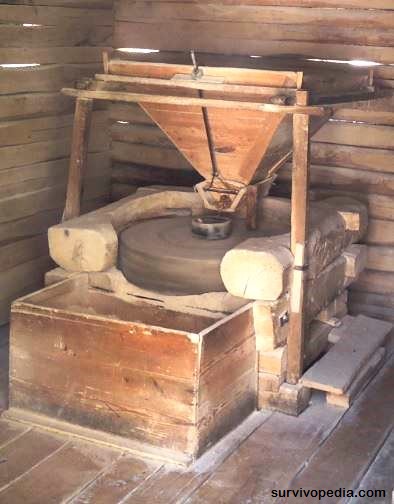
If you are going to bug out or live in a larger survival community, there should already be a community based grain mill that everyone can use to process larger amounts of flour.
Even if this mill is only used on a weekly schedule, it should be able to process several pounds of flour or more at a time.
Aside from survival communities, homesteads should also have a larger grain mill so that processing can be done at the best possible time.
Individuals that are bugging in or have very little space should still try to have a large enough grain mill to meet daily needs, and process at least 6 – 7 cups of flour at a time.
If you are using micro-harvest plants or other small scale growing systems, then this grain mill will optimize both your time and processing capacity.
When choosing a grain mill design, think about how you will adapt it to produce different textures and flour weights. If you are building a large sized grain mill, you should focus on a creating a coarse flour, and then use smaller mills for progressively lighter flours. Alternatively, if you need mid-weight and light weight flour, build the grain mill in such a way that you can change the grinding mechanism without having to make extensive changes to the way the mill is powered.
Remember that the bigger the mill, the more power it will take to operate it, and even a slight increase in the size of the internal grinder can make a hand powered mill impossible to use. That’s why you have to think about how you will adjust the grain mill to run on other power sources.
For example, if you think that an animal powered mill suits your needs, do not overlook powering the mill by finding ways to place it in a nearby stream. While keeping different sized mills on hand can help with power associated problems, yow will also need to consider how to make your designs as adaptive as possible. This is especially important if you decide to use electric powered grain mills that will eventually require new motors or sources of electricity in order to use them.
Basic Parts of a Grain Mill
Before building a grain mill, it is important to know what parts every mill has in common as well as the best materials. Fortunately, grain mills are not especially complex, however choosing the best materials can be more time consuming than expected.
Grain Hopper
This is where the grain will be held while the grain mill is in operation. The hopper can be made of canvas or just about anything else that will hold grain. In order to make your design as compact as possible, try to make detbrewachable and foldable hoppers.
If you are going to make a larger grain mill, then it may also be a good idea to make the hopper in such a way that it will act as a cover for the internal mechanism when not in use. The last thing you will want to do is invest in building a larger grain mill with metal rollers only to have the rollers develop rust or some other form of corrosion. By the same token, you will not want wooden rollers to rot or stone ones to develop moss or algae buildups.
Grain Mill Body
The body of the grain mill should be durable enough to withstand the weight of the hopper and grain. It should also be able to take the friction created by the rollers without falling apart.
Hand sized grain mills can be made of wood or even plastic. Larger mills can be made with cement frames, wood, metal, or stone. You may also want to explore some of the more durable polymer products that will enable you to make different body shapes that will accommodate different power sources or roller sizes with less difficulty.
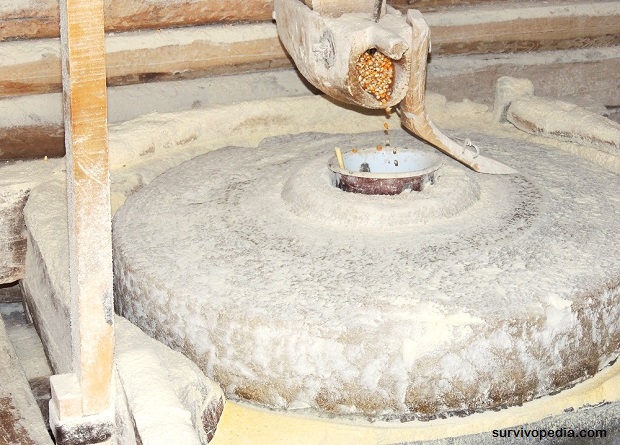
As the heart of the grain mill, the rollers are the most important. Some people have used PVC plastic, while others prefer metal, wood, stone, ceramic, or even polymer rollers.
Regardless of the material, you will need to experiment with the distance between the rollers as well as the best surface. It may be to your advantage to have several different rollers with differing degrees of smoothness as well as a means to set the rollers closer and further apart.
Power Source
The simplest grain mills rely on a crank that can be turned either by a human or animal. More complex grain mills can be turned by a series of gears and water power. You should also consider designs that are based on the ancient revolving hammers in China. Not only are these fascinating hammers the basis for modern pneumatic hammers, they can also be used for metal shaping as well as making good quality grain.
Study the shaft assemblies carefully for these devices and you will see that they can as easily be driven by a water wheel as they can a wind turbine or other non-electric based power sources.
Flour Hopper
Once the grain passes through the rollers, you will need a place to store it. The flour hopper should be easy to remove and clean. You can use anything from a ceramic bowl to larger plastic vessels. Just make sure that the flour hopper can remain covered at all times, and that the seal between the hopper and the bottom of the grain mill does not allow dust to escape.
Dust Control
Many people are surprised to find out that grinding grains and corn can produce quite a bit of dust. To reduce this problem as much as possible, make sure that the body of the mill, grain, and flour hoppers all fit together tightly. You can use caulk and sealing agents to help with cracks and other areas where dust can get through.
Small Grain Mill Designs
Small sized grain mills can be powered by hand. They should be able to process 1 – 6 cups of flour at a time. In most cases,it will take from 1 to 5 minutes to grind a single cup of flour. Small grain mills are best suited for refining flour that has already gone through a larger mill as well as for processing grain directly.
Crank Mills
You can make any number of simple designs. This includes ones that have two rollers as well as sifters that utilize a screen on the bottom and a wire loop (or downward angled blades) inside the body. Simply turn the crank in order to turn the rollers, blades, or wire loop. As the grinding unit moves, grain will be fall into the path of the crushing elements and then fall into the hopper waiting below.
Gear Mills
As you may be aware, gears can be attached to a crank in such a way that one turn of the crank produces 2 or more revolutions in the rollers or wire loop attached to it. A gear system will process flour faster, however the gears can also wear out or break. For best results, use metal gears instead of plastic ones.
Gravity Motor Mills
These mills are similar to power generation motors in the sense that they use gravity to turn an object. In this case, you would need several feet of space so that the rollers can be turned as a counterweight falls to the ground. This design will require a gear assembly to optimize rotation as well as to get as much power as possible for turning the rollers.
Electric Powered Mills
If you happen to have a motor on hand and some electricity, these mills can be created in any number of designs. This includes using food processor blades as well as other designs that can be used to crush or cut grains apart.
Midsized Grain Mill Designs
These grain mills should process at least 10 pounds of flour at a time. You can still use crank, gear, gravity, and electric motors to power these mills. On the other hand, you might find that cement, metal, or more durable materials will be needed for these mills.
Large Grain Mill Designs
Trip and Pneumatic Hammer Mills
Trip hammer based mills basically use a central axis that turns several hammers, each in their own turn. Here is a basic design that has been used in China for centuries. It can process several pounds of grain at a time, or if built correctly, can also be used to pound metal into any number of shapes.
You can also study more modern designs that feature smaller hammers that can be driven by an electric motor. If you give it some thought, you will also see how to upscale these smaller designs so that they can be used with stones or other materials.
Animal Driven Mills
Historically speaking, these mills can be driven by both humans and animals that walk around in circles to turn large stones that grind the flour. In order to optimize these designs, consider adding a gear assembly, or better yet, take a hammer mill design and shift it to a horizontal axis instead of a vertically driven one.
Water Wheel Driven Mills
The size of these mills will be determined by the speed and amount of water flowing in the area. Smaller mills can be operated in streams, however you will need a fast moving river if you plan to process larger amounts. Together with above ground versions, you may also want to try and create designs that utilize water pressure built up in underground pipes.
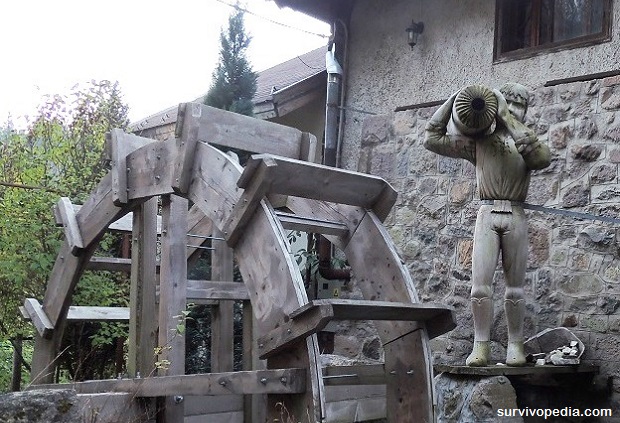
Motorized Mills
The best motorized mills for a homestead will most likely be driven by wind turbines. You can study windmills from Holland as well as the United States that were built for this purpose.
Video first seen on 32bituser.
Typically, these mills can easily last for centuries. If you want to optimize these mills using modern technologies, consider making the blades from polymers that will combine lighter weight with enough durability to withstand the physical force required to mill grain.
When it comes to grain and flour mills for survivors, more than a few people think that they can get away with a small mill, or even none at all. If you already have a hand mill, simply stop and think about whether or not you have 2 – 3 hours a day to sit around and grind grain. In the post crisis world, where you will have to perform many other tasks, you may have even less time to devote to grinding grain.
Study larger mills and also smaller ones that do not rely completely on hand power. For example, if you are going to build a hand power mill, at least consider gravity motors if you do not want to have all the worries associated with electric motors. If there is more than one person in your survival group, you are also going to find a mid to large sized grain mill absolutely essential.
Knowing how a grain mill is built is one trick that helps your prepping purposes. More valuable secrets from our ancestors are still to be discovered and developed for survival. CLICK on the banner below to find out more about the undisclosed tricks that helped our parents survive!
This article has been written by Carmela Tyrell for Survivopedia.
References
en.wikipedia.org/wiki/Trip_hammer
web.hammermills.com/blog/bid/80081/Hammer-Mills-5-Key-Styles-You-Need-to-Know-About
homebrewtalk.com/showthread.php?t=119521
homebrewersassociation.org/pimp-my-system/build-your-own-grain-mill/
instructables.com/id/Build-a-Quiet-Home-Brewing-Grain-Mill/
























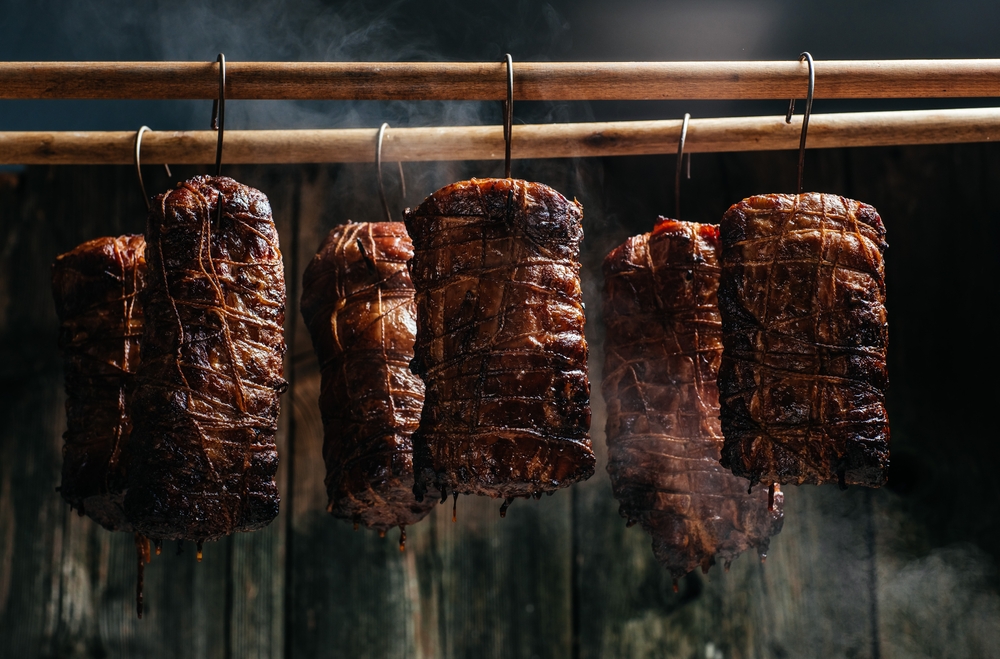



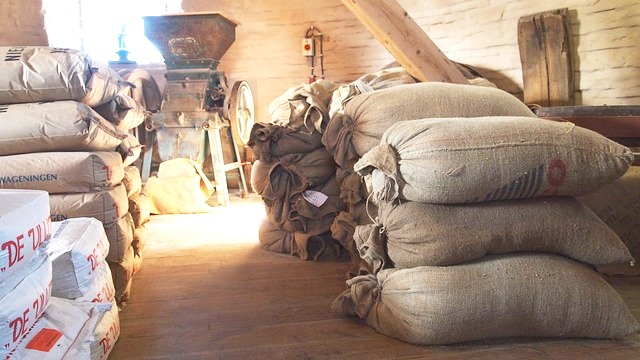




























































Comments 2